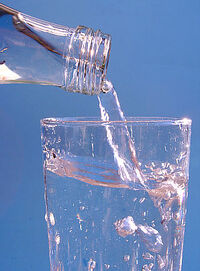mNo edit summary |
No edit summary |
||
| (7 intermediate revisions by 5 users not shown) | |||
| Line 1: | Line 1: | ||
[[Image:Stilles Mineralwasser.jpg|200px|right]] |
[[Image:Stilles Mineralwasser.jpg|200px|right]] |
||
| − | + | Water is both added to food as an ingredient and used to transfer heat for cooking. |
|
For both such purposes, the water should be generally drinkable. Water is a common source of disease organisms. [[Boiling]] water for about 5 minutes should take care of this problem. Baked goods containing water also need to be kept at a boiling temperature to prevent the spread of disease. |
For both such purposes, the water should be generally drinkable. Water is a common source of disease organisms. [[Boiling]] water for about 5 minutes should take care of this problem. Baked goods containing water also need to be kept at a boiling temperature to prevent the spread of disease. |
||
| Line 7: | Line 7: | ||
Water-based cooking methods include: |
Water-based cooking methods include: |
||
| − | *[[blanching]] |
+ | * [[blanching]] |
| − | *[[boiling]] |
+ | * [[boiling]] |
| − | *[[poaching]] |
+ | * [[poaching]] |
| − | *[[simmering]] |
+ | * [[simmering]] |
| − | *[[steaming]] |
+ | * [[steaming]] |
| + | * |
||
==Water for fermenting== |
==Water for fermenting== |
||
| − | When adding water to a [[fermentation|fermented food]], it is generally best to use water with little or no chlorine. Chlorine is added to water to kill harmful microbes such as bacteria, and as such, can change how well a fermentation progresses, by slowing it down or even by ruining it. |
+ | When adding water to a [[fermentation|fermented food]], it is generally best to use water with little or no chlorine. Chlorine is added to water to kill harmful microbes such as bacteria, and as such, can change how well a fermentation progresses, by slowing it down or even by ruining it. |
| − | Commercial [[yeast]] ferments like [[beer]] are not as sensitive to chlorine as yeast / bacteria ferments like [[ |
+ | Commercial [[yeast]] ferments like [[beer]] are not as sensitive to chlorine as yeast / bacteria ferments like [[wikipedia:sourdough|sourdough]], but often still benefit from chlorine-free water as it also affects the taste of the final product. |
Chlorine can be removed from tap water by boiling for a few minutes and leaving to cool. Also, leaving uncovered overnight (e.g. in the [[refrigerator]]) will reduce chlorine. However, some water suppliers are now using the more stable chloramine instead, which cannot be boiled out and will remain stable in water for longer periods. Many water filters will remove both chlorine and chloramine. |
Chlorine can be removed from tap water by boiling for a few minutes and leaving to cool. Also, leaving uncovered overnight (e.g. in the [[refrigerator]]) will reduce chlorine. However, some water suppliers are now using the more stable chloramine instead, which cannot be boiled out and will remain stable in water for longer periods. Many water filters will remove both chlorine and chloramine. |
||
==Source== |
==Source== |
||
| − | *[http://en.wikibooks.org/w/index.php?title=Cookbook:Water&action=edit Water] from the Wikibooks Cookbook—original source of article, licensed under the GNU Free Documentation License. |
+ | * [http://en.wikibooks.org/w/index.php?title=Cookbook:Water&action=edit Water] from the Wikibooks Cookbook—original source of article, licensed under the GNU Free Documentation License. |
| ⚫ | |||
| − | |||
| ⚫ | |||
| − | |||
| ⚫ | |||
| ⚫ | |||
Revision as of 23:20, 15 February 2020
Water is both added to food as an ingredient and used to transfer heat for cooking.
For both such purposes, the water should be generally drinkable. Water is a common source of disease organisms. Boiling water for about 5 minutes should take care of this problem. Baked goods containing water also need to be kept at a boiling temperature to prevent the spread of disease.
Water-based cooking methods include:
Water for fermenting
When adding water to a fermented food, it is generally best to use water with little or no chlorine. Chlorine is added to water to kill harmful microbes such as bacteria, and as such, can change how well a fermentation progresses, by slowing it down or even by ruining it.
Commercial yeast ferments like beer are not as sensitive to chlorine as yeast / bacteria ferments like sourdough, but often still benefit from chlorine-free water as it also affects the taste of the final product.
Chlorine can be removed from tap water by boiling for a few minutes and leaving to cool. Also, leaving uncovered overnight (e.g. in the refrigerator) will reduce chlorine. However, some water suppliers are now using the more stable chloramine instead, which cannot be boiled out and will remain stable in water for longer periods. Many water filters will remove both chlorine and chloramine.
Source
- Water from the Wikibooks Cookbook—original source of article, licensed under the GNU Free Documentation License.

